By Leen Randell
Updated: Jul 04, 2024
10 Best Herbal Decoctions For High Blood Pressure
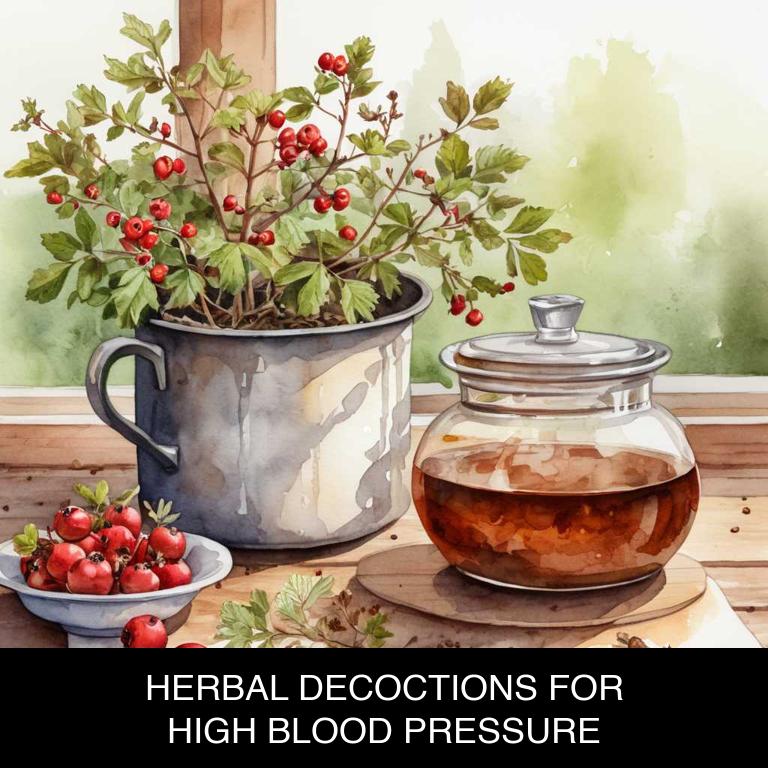
Herbal decoctions for high blood pressure are concentrated liquid extracts made from various herbs, roots, and leaves that have been traditionally used to lower blood pressure.
These decoctions help by dilating blood vessels, improving circulation, and reducing stress on the heart. For example, hawthorn berries and garlic extract are commonly used herbal decoctions that have been shown to effectively reduce blood pressure and improve overall cardiovascular health.
By incorporating these natural remedies into their daily routine, individuals with high blood pressure can experience a significant reduction in symptoms, improved energy levels, and enhanced quality of life.
The following article describes in detail the most important decoctions for high blood pressure, including medicinal properties, parts of herbs to use, and recipes for preparations.
- 1. Crataegus monogyna
- 2. Ginkgo biloba
- 3. Tilia europaea
- 4. Prunella vulgaris
- 5. Valeriana officinalis
- 6. Lavandula angustifolia
- 7. Stevia rebaudiana
- 8. Melissa officinalis
- 9. Crataegus pinnatifida
- 10. Vitis vinifera
- What is the best combination of herbal decoctions to use for high blood pressure?
- What ailments similar to high blood pressure are treated with herbal decoctions?
1. Crataegus monogyna
Hawthorn decoctions helps with high blood pressure because it is a natural vasodilator that relaxes and widens blood vessels, allowing blood to flow more easily through the body.
The flavonoids present in hawthorn extract also help to reduce peripheral resistance, which can contribute to hypertension.
Additionally, hawthorn decoctions may help to strengthen the heart muscle and improve cardiac output, further reducing the workload on the heart and lowering blood pressure naturally.
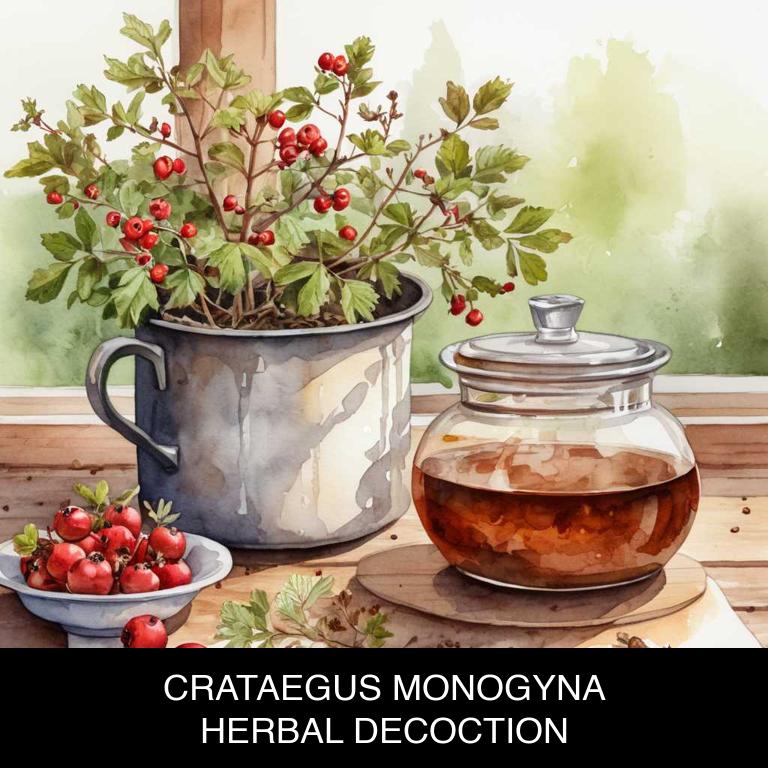
Medicinal Constituents
The list below shows the primary medicinal constituents in Crataegus monogyna decoctions that help with high blood pressure.
- Flavonoids: These polyphenolic compounds help reduce blood pressure by exerting vasodilatory effects, improving blood vessel function, and enhancing endothelial function.
- Triterpenoids: These compounds have been shown to reduce blood pressure by inhibiting the renin-angiotensin-aldosterone system, decreasing vascular resistance, and reducing inflammation in blood vessels.
- Polyphenolic acids: These compounds help lower blood pressure by reducing oxidative stress, improving blood vessel function, and inhibiting the production of vasoconstrictor hormones.
Parts Used
The list below shows the primary parts of hawthorn used to make decoctions for high blood pressure.
- Leaves: They are used for their antioxidant and anti-inflammatory properties, which help to lower blood pressure.
- Fruits: They are used due to their flavonoid content, which has been shown to have a positive effect on cardiovascular health and reduce blood pressure.
- Barks: They are used for their astringent and antispasmodic properties, which can help to reduce blood pressure and prevent cardiovascular issues.
Quick Recipe
The following recipe gives a procedure to make a basic hawthorn for high blood pressure.
- Harvest 20-30g of fresh or dried leaves and branches of crataegus monogyna in late summer or early autumn.
- Dry the harvested material in a warm place for 2-3 hours or until completely dry.
- Combine 10g of dried crataegus monogyna material with 1 liter of boiling water to create decoction.
- Simmer the mixture for 10-15 minutes then strain it using a cheesecloth or fine-mesh sieve.
- Store the cooled decoction in the refrigerator for up to 24 hours before consumption.
2. Ginkgo biloba
Maidenhair tree decoctions helps with high blood pressure because its potent combination of flavonoids, saponins, and terpenoids exhibits a dual-action mechanism.
Firstly, it relaxes blood vessels, allowing for improved blood flow and reduced resistance, thereby decreasing diastolic blood pressure. Secondly, the decoction's antioxidants help to reduce inflammation in the cardiovascular system, which is often a contributing factor to high blood pressure.
This synergistic effect makes maidenhair tree decoctions a natural and effective remedy for managing hypertension.
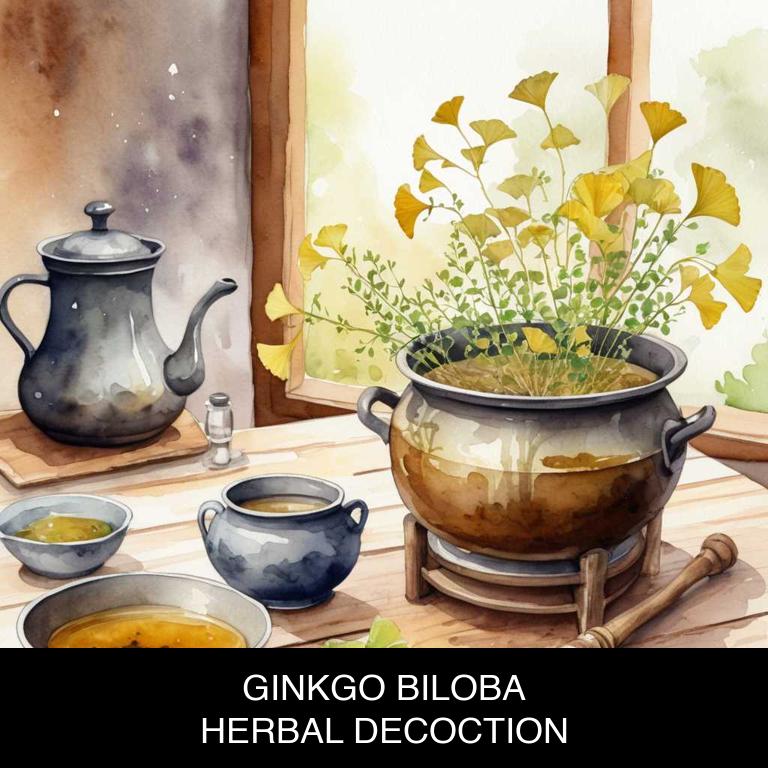
Medicinal Constituents
The list below shows the primary medicinal constituents in Ginkgo biloba decoctions that help with high blood pressure.
- Flavonoids: These compounds help to relax blood vessels and improve blood flow, reducing blood pressure by increasing nitric oxide production and reducing oxidative stress.
- Terpenoids: Bilobalide has been shown to have vasodilatory effects, reducing blood pressure by improving blood vessel function and reducing vascular resistance.
- Triterpenoids: Ginkgolide B has been found to inhibit platelet aggregation and reduce blood pressure by reducing blood vessel constriction and improving blood flow.
Parts Used
The list below shows the primary parts of maidenhair tree used to make decoctions for high blood pressure.
- Leaves: They are used due to their flavonoid and terpenoid content, which has been shown to help improve blood flow and reduce blood pressure.
- Seeds: They are used for their flavonoid content, particularly bilobalide, which has been shown to have vasodilatory effects and help lower blood pressure.
- Barks: They are used due to their flavonoid and terpenoid content, which has been shown to have antioxidant and vasodilatory effects, helping to reduce blood pressure and improve cardiovascular health.
Quick Recipe
The following recipe gives a procedure to make a basic maidenhair tree for high blood pressure.
- Measure out 3-6 grams of dried ginkgo biloba leaves and flowers for a standard decoction.
- Combine the measured herbs with 1 liter of pure water in a saucepan and bring to a boil.
- Reduce heat and allow the mixture to simmer for 5-10 minutes or until the liquid has reduced slightly.
- Strain the decoction through a cheesecloth or fine-mesh sieve into a clean container to remove solids.
- Store the cooled decoction in the refrigerator for up to 3 days to preserve its potency and flavor.
3. Tilia europaea
Lime decoctions helps with high blood pressure because they contain bioactive compounds that can effectively regulate blood vessel tone, reducing resistance to blood flow.
The citric acid in lime juice helps to relax blood vessels, improving blood circulation and lowering blood pressure.
Additionally, the flavonoids present in limes have been shown to improve blood vessel function by increasing nitric oxide production, further contributing to a decrease in blood pressure levels.
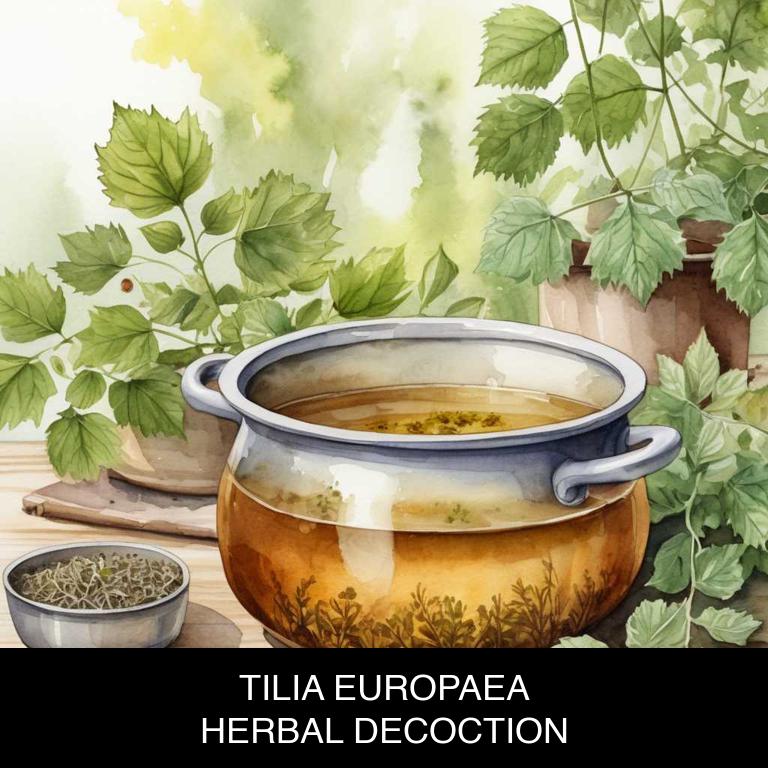
Medicinal Constituents
The list below shows the primary medicinal constituents in Tilia europaea decoctions that help with high blood pressure.
- Flavonoids: These plant-based compounds help with high blood pressure by reducing inflammation and improving blood vessel function, thus promoting better blood flow and lowering blood pressure.
- Terpenes: Specifically, terpenes like borneol and borneol acetate in Tilia europaea may help reduce high blood pressure by exerting a vasodilatory effect, which is the widening of blood vessels to improve circulation and lower blood pressure.
- Flavonoid glycosides: These compounds, including quercetin and kaempferol in Tilia europaea, may help with high blood pressure by inhibiting the activity of angiotensin-converting enzyme (ACE), a key component in the renin-angiotensin-aldosterone system that regulates blood pressure.
Parts Used
The list below shows the primary parts of lime used to make decoctions for high blood pressure.
- Leaves: They are rich in potassium, which can help balance out the effects of sodium and reduce blood pressure.
- Flowers: The flowers of Tilia europaea have been used in herbal medicine to help calm the nervous system and reduce stress, which can contribute to high blood pressure.
Quick Recipe
The following recipe gives a procedure to make a basic lime for high blood pressure.
- Harvest 20g of dried flowers and leaves of tilia europaea in late summer or early autumn.
- Chop the harvested material into smaller pieces to increase the surface area for infusion.
- Combine the chopped tilia europaea with 500ml of boiling water in a heat-resistant container.
- Steep the mixture for 5-10 minutes to allow the active compounds to infuse into the water.
- Strain the decoction through a cheesecloth or a fine-mesh sieve into a separate container.
4. Prunella vulgaris
Selfheal decoctions helps with high blood pressure because it is rich in antioxidants, flavonoids, and phenolic acids that help to relax blood vessels and reduce inflammation.
The decoction's bioactive compounds also have a direct effect on the cardiovascular system, improving blood flow and reducing peripheral resistance.
By addressing these underlying factors, selfheal decoctions can effectively lower systolic and diastolic blood pressure, alleviating symptoms of hypertension and promoting overall heart health.
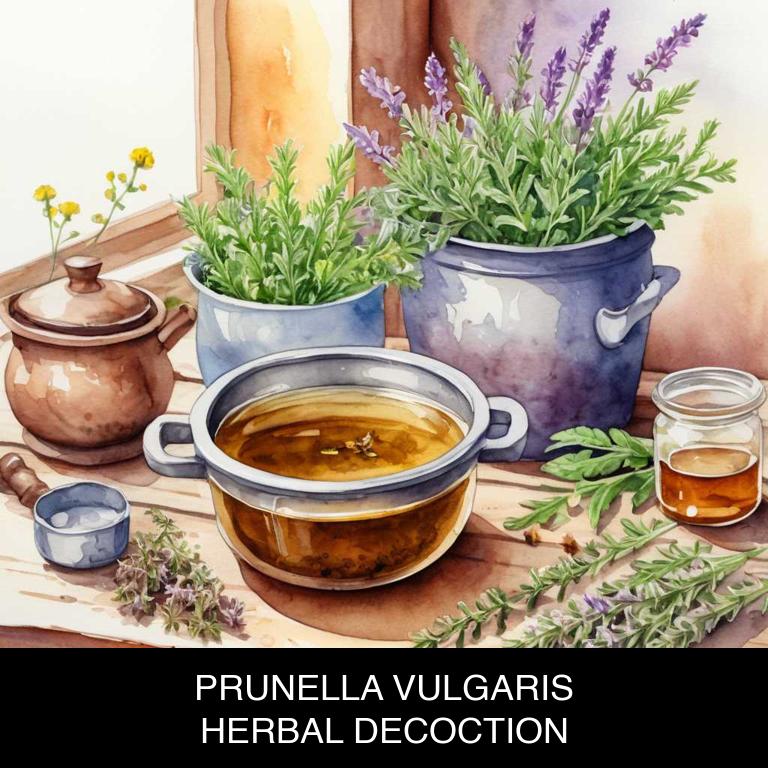
Medicinal Constituents
The list below shows the primary medicinal constituents in Prunella vulgaris decoctions that help with high blood pressure.
- Phenolic acids: These compounds help to lower blood pressure by relaxing blood vessels, allowing them to expand and reduce blood pressure.
- Flavonoids: Rutin has been shown to have vasodilatory effects, which help to widen blood vessels and reduce blood pressure.
- Saponins: Saponins have been found to have anti-inflammatory and antioxidant properties, which can help to reduce stress on the cardiovascular system and contribute to lower blood pressure.
Parts Used
The list below shows the primary parts of selfheal used to make decoctions for high blood pressure.
- Leaves: They are used due to their high concentration of flavonoids and phenolic acids, which have been shown to have vasodilatory effects and help reduce blood pressure.
- Roots: The roots of Prunella vulgaris contain compounds that help in regulating blood pressure and improving cardiovascular health by reducing oxidative stress and inflammation.
- Stems: The stems of the plant are used in traditional medicine to treat high blood pressure due to their ability to relax blood vessels and improve circulation.
Quick Recipe
The following recipe gives a procedure to make a basic selfheal for high blood pressure.
- Harvest prunella vulgaris leaves and flowers in early summer when they are in full bloom and dry them properly.
- Measure out 1-2 teaspoons of dried prunella vulgaris per cup of water for the decoction.
- Combine the measured dried prunella vulgaris with 1 cup of water in a saucepan and bring to a boil.
- Reduce the heat to a simmer and let the mixture steep for 5-10 minutes to release the active compounds.
- Strain the decoction using a fine-mesh sieve or cheesecloth and discard the solids to obtain the final product.
5. Valeriana officinalis
Valerian decoctions helps with high blood pressure because they promote relaxation and reduce stress, two major contributors to hypertension.
The valerenic acids in valerian root tea have a calming effect on the nervous system, slowing down an individual's heart rate and allowing for more efficient blood flow. This natural relaxation response also reduces cortisol levels, which can help regulate blood pressure.
Additionally, valerian decoctions may dilate blood vessels, allowing blood to flow more easily and reducing pressure on the cardiovascular system.
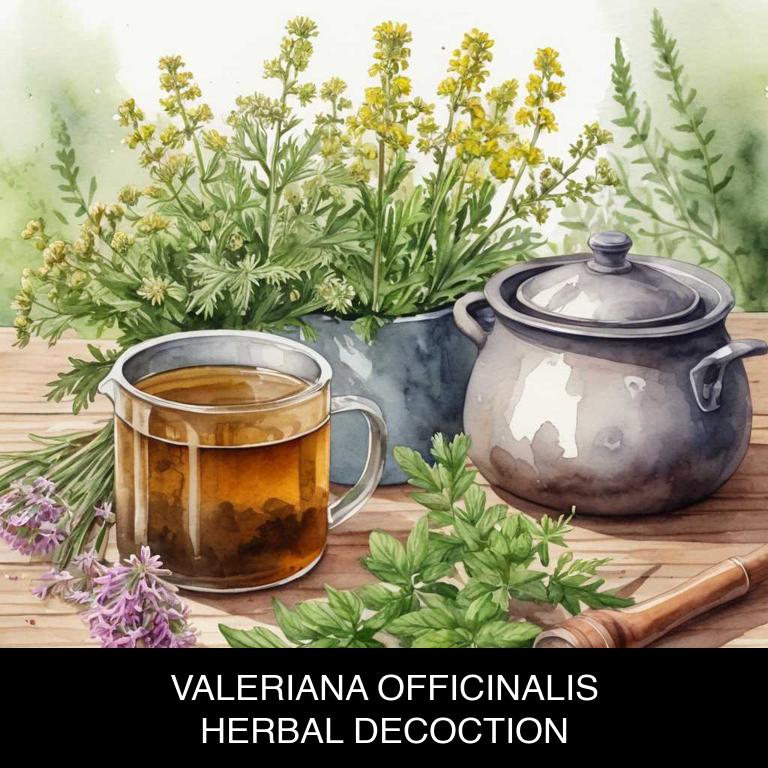
Medicinal Constituents
The list below shows the primary medicinal constituents in Valeriana officinalis decoctions that help with high blood pressure.
- Valerenic acid: Valerenic acid is a sesquiterpene, which has been shown to have vasodilatory effects, helping to relax blood vessels and reduce blood pressure.
- Valerenol: Valerenol is a sesquiterpene that has been found to inhibit the activity of angiotensin-converting enzyme (ACE), a key enzyme involved in blood pressure regulation, thereby contributing to its blood pressure-lowering effects.
- Lignans: Lignans, a type of phenolic compound, have antioxidant and anti-inflammatory properties that may help reduce inflammation and oxidative stress, both of which are associated with high blood pressure and cardiovascular disease.
Parts Used
The list below shows the primary parts of valerian used to make decoctions for high blood pressure.
- Roots: Valerian roots are commonly used due to their high concentration of valerenic acid, which has a sedative effect and can help lower blood pressure.
- Stems: Valerian stems may be used as a secondary option due to their ability to contain a smaller amount of the active compounds that contribute to the medicinal properties of the plant.
- Leaves: Although not as potent as the roots, valerian leaves can still be used in decoctions to contribute to the overall medicinal effects of the plant, although to a lesser extent.
Quick Recipe
The following recipe gives a procedure to make a basic valerian for high blood pressure.
- Harvest 1-2 pounds of fresh roots or 1/2 cup of dried roots of valeriana officinalis for decoction.
- Clean the roots by gently scrubbing them with a brush and rinse with cold water to remove dirt.
- Chop the roots into small pieces and add 2 cups of water to a saucepan for every 1/2 cup of roots.
- Bring the water to a boil and then reduce heat to a simmer for 10-15 minutes or until reduced by half.
- Strain the decoction through a cheesecloth or a coffee filter into a clean container and discard the solids.
6. Lavandula angustifolia
English lavender decoctions helps with high blood pressure because of its ability to relax the body's blood vessels, allowing for smoother circulation and reducing constriction.
The herb's active compounds, such as linalool and linalyl acetate, have been shown to possess vasodilatory properties, which help to decrease blood pressure readings.
Additionally, lavender's calming effects on the nervous system can also contribute to its hypotensive actions, promoting a sense of relaxation and reducing stress-induced hypertension.
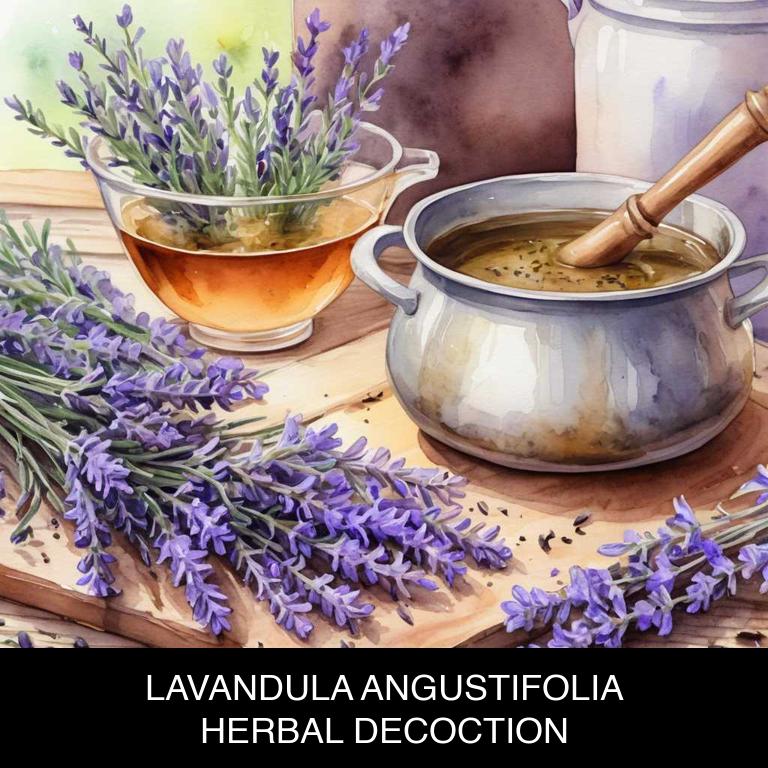
Medicinal Constituents
The list below shows the primary medicinal constituents in Lavandula angustifolia decoctions that help with high blood pressure.
- Linalool: A terpene with vasodilatory properties, which helps to relax blood vessels and reduce blood pressure.
- Luteolin: A flavonoid with antioxidant and anti-inflammatory properties, which can help to reduce oxidative stress and inflammation in blood vessels, contributing to lower blood pressure.
- Linalyl acetate: A terpene with vasodilatory and anti-inflammatory effects, which may help to reduce blood pressure by improving blood flow and reducing vascular resistance.
Parts Used
The list below shows the primary parts of english lavender used to make decoctions for high blood pressure.
- Leaves: They are used for their potential to reduce blood pressure due to their vasodilatory and antioxidant properties.
- Flowers: The flowers are used for their calming and relaxing effects, which can help alleviate high blood pressure by reducing stress and anxiety.
- Stems: The stems of Lavandula angustifolia contain bioactive compounds that may help lower blood pressure by reducing inflammation and promoting cardiovascular health.
Quick Recipe
The following recipe gives a procedure to make a basic english lavender for high blood pressure.
- Harvest 20-30 lavandula angustifolia flowers at the peak of blooming for best potency and flavor.
- Dry the flowers in a well-ventilated area for 1-2 weeks to preserve their properties and aroma.
- Combine 1 teaspoon of dried lavandula angustifolia flowers with 1 cup of boiling water for a decoction.
- Steep the mixture for 5-10 minutes to allow the flowers to release their active compounds into the water.
- Strain the decoction and discard the solids to enjoy the relaxing and calming benefits of the tea.
7. Stevia rebaudiana
Stevia decoctions helps with high blood pressure because it contains bioactive compounds that exhibit vasodilatory properties, which help to relax and widen blood vessels.
This increased blood flow reduces peripheral resistance, leading to a decrease in blood pressure. Additionally, stevia's antioxidant and anti-inflammatory effects may also contribute to its hypotensive activity by protecting against oxidative stress and inflammation, common underlying factors of high blood pressure.
As a result, stevia decoctions can be a valuable natural adjunctive therapy for managing hypertension.
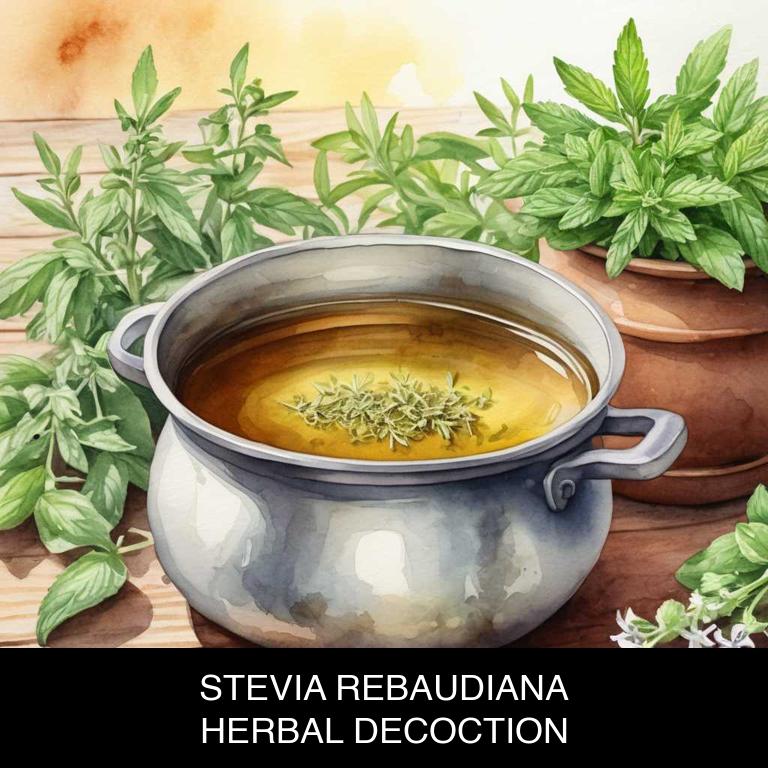
Medicinal Constituents
The list below shows the primary medicinal constituents in Stevia rebaudiana decoctions that help with high blood pressure.
- Saponins: Saponins help with high blood pressure by reducing blood pressure through their diuretic and vasodilatory effects, which increase urine production and relax blood vessels, respectively.
- Polyphenols: Polyphenols, particularly flavonoids and phenolic acids, help with high blood pressure by inhibiting the activity of angiotensin-converting enzyme (ACE), a key component in the renin-angiotensin-aldosterone system that regulates blood pressure.
- Rebaudioside a: Rebaudioside A, a glycoside and a sweet compound, helps with high blood pressure by inhibiting the activity of the epithelial sodium channel (ENaC), which plays a crucial role in sodium retention and blood pressure regulation.
Parts Used
The list below shows the primary parts of stevia used to make decoctions for high blood pressure.
- Leaves: Leaves are the primary part used due to their high glycoside content, particularly stevioside and rebaudioside, which have been shown to help lower blood pressure.
- Roots: Roots are also commonly used as they contain a high concentration of the bioactive compounds that help in regulating blood pressure.
- Stems: Stems are used for decoctions due to their rich content of steviol glycosides, which have been found to exhibit antioxidant and anti-hypertensive properties.
Quick Recipe
The following recipe gives a procedure to make a basic stevia for high blood pressure.
- Harvest 1-2 pounds of stevia rebaudiana leaves and flowers from mature plants with no signs of pests or diseases.
- Dry the harvested stevia rebaudiana leaves and flowers in a shaded area with good air circulation for 7-10 days.
- Measure 1-2 teaspoons of dried stevia rebaudiana leaves and flowers and add them to a glass container.
- Pour 1 quart of boiling water over the dried stevia rebaudiana leaves and flowers in the container.
- Steep the mixture for 5-10 minutes and then strain it through a cheesecloth or a fine-mesh sieve into a separate container.
8. Melissa officinalis
Lemon balm decoctions helps with high blood pressure because it contains flavonoids, which have been shown to improve blood vessel function and lower blood pressure by relaxing the muscles in blood vessel walls.
Additionally, lemon balm has been found to help reduce stress and anxiety, common triggers of high blood pressure, by promoting relaxation and reducing cortisol levels.
By addressing these underlying causes, herbal lemon balm decoctions can be a natural and effective way to support blood pressure management.
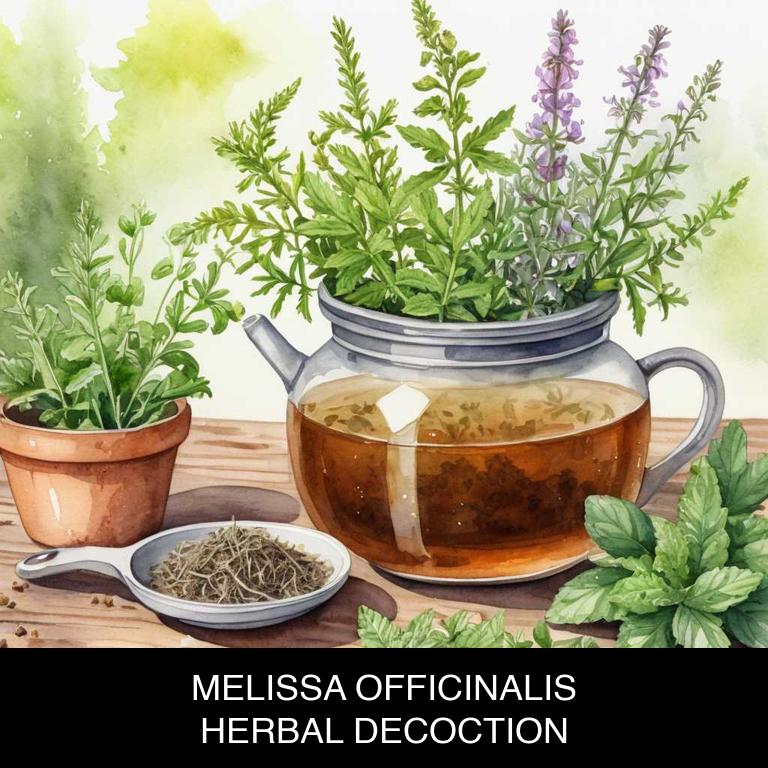
Medicinal Constituents
The list below shows the primary medicinal constituents in Melissa officinalis decoctions that help with high blood pressure.
- Rosmarinic acid: This phenolic compound has antioxidant and anti-inflammatory properties, which help to reduce blood pressure by counteracting oxidative stress and inflammation in blood vessels.
- Luteolin: As a flavonoid, luteolin exhibits vasodilatory effects, causing blood vessels to relax and widen, thereby decreasing blood pressure and improving cardiovascular health.
- Melissic acid: This terpenoid has been shown to have a diuretic effect, helping to increase urine production and reduce fluid retention, which in turn can lower blood pressure.
Parts Used
The list below shows the primary parts of lemon balm used to make decoctions for high blood pressure.
- Leaves: The leaves of Melissa officinalis are commonly used due to their high content of flavonoids and phenolic acids, which have been shown to have a positive effect on blood pressure.
- Flowers: The flowers are often used for their antioxidant and anti-inflammatory properties, which can help to reduce inflammation and improve cardiovascular health.
- Roots: The roots of Melissa officinalis contain a high amount of phenolic compounds, which have been found to have a relaxing effect on blood vessels and may help to lower blood pressure.
Quick Recipe
The following recipe gives a procedure to make a basic lemon balm for high blood pressure.
- Harvest 1/2 cup of melissa officinalis leaves in the morning after the dew has evaporated.
- Wash the harvested leaves with cold water to remove any dirt or impurities.
- Chop 1/4 cup of the washed leaves into small pieces using a sharp knife.
- Steep 2 tablespoons of the chopped leaves in 1 cup of boiling water for 5-10 minutes.
- Strain the decoction through a cheesecloth or a fine-mesh sieve into a cup.
9. Crataegus pinnatifida
Chinese hawthorn decoctions helps with high blood pressure because of its unique combination of bioactive compounds, including flavonoids, triterpenic acids, and oligomeric proanthocyanidins.
These compounds work synergistically to relax blood vessels, improve blood flow, and reduce peripheral resistance, thereby lowering systolic and diastolic blood pressure.
Additionally, hawthorn decoctions have been shown to increase nitric oxide production, which helps to dilate blood vessels and further contribute to its hypotensive effects, making it a natural and effective adjunctive therapy for managing high blood pressure.
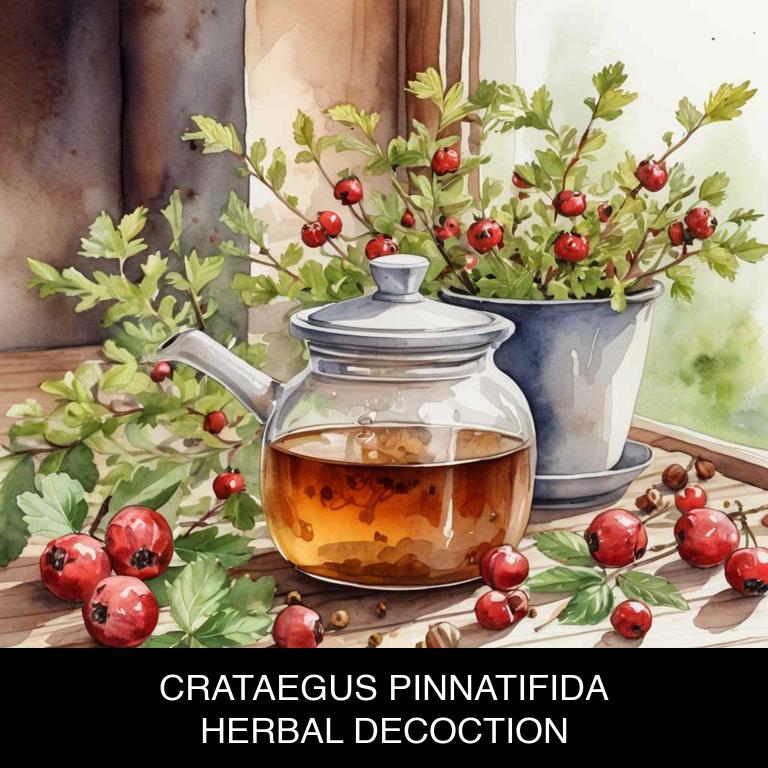
Medicinal Constituents
The list below shows the primary medicinal constituents in Crataegus pinnatifida decoctions that help with high blood pressure.
- Flavonoids: These polyphenolic compounds help with high blood pressure by inhibiting the angiotensin-converting enzyme (ACE), which plays a key role in regulating blood pressure.
- Tannins: Tannins, particularly gallotannins, have been found to have vasodilatory effects, which can help lower blood pressure by relaxing blood vessels and improving blood flow.
- Crataegus saponins: These saponins have been shown to exert a positive effect on cardiovascular function by inhibiting the sympathetic nervous system, leading to reduced blood pressure and improved heart function.
Parts Used
The list below shows the primary parts of chinese hawthorn used to make decoctions for high blood pressure.
- Fruits: The fruits are used due to their high content of flavonoids and other bioactive compounds, which are believed to have cardiovascular protective effects.
- Leaves: The leaves are used due to their antioxidant and anti-inflammatory properties, which can help to reduce blood pressure and improve cardiovascular health.
- Barks: The barks are used due to their content of phenolic acids and other bioactive compounds, which can help to reduce inflammation and improve cardiovascular function.
Quick Recipe
The following recipe gives a procedure to make a basic chinese hawthorn for high blood pressure.
- Harvest 10-15 grams of dried crataegus pinnatifida leaves and flowers in late summer or early fall.
- Grind the harvested material into a fine powder using a mortar and pestle.
- Combine the powder with 1 liter of water and bring to a boil in a saucepan.
- Reduce the heat and simmer for 10-15 minutes or until the liquid has reduced by half.
- Strain the decoction using a cheesecloth or a fine-mesh sieve and discard the solids.
10. Vitis vinifera
Grape decoctions helps with high blood pressure because they contain powerful flavonoids, such as resveratrol, that have a profound impact on cardiovascular health.
These compounds help to relax and dilate blood vessels, reducing the strain on the heart and lowering blood pressure.
Additionally, grape decoctions may also help to improve circulation, reduce inflammation, and enhance overall vascular function, all of which contribute to a significant decrease in blood pressure.
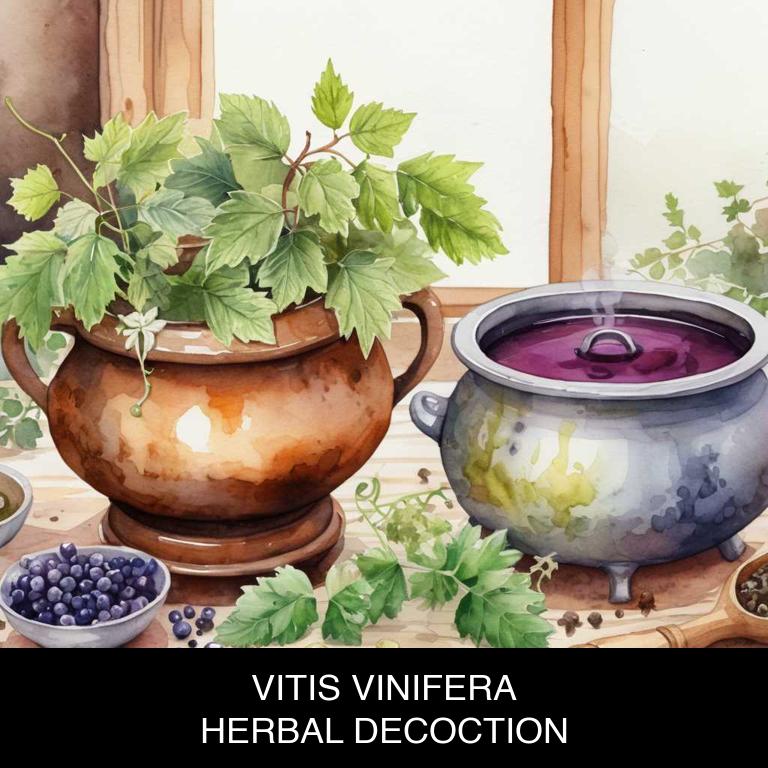
Medicinal Constituents
The list below shows the primary medicinal constituents in Vitis vinifera decoctions that help with high blood pressure.
- Quercetin: As a flavonoid with strong antioxidant and anti-inflammatory properties, quercetin helps reduce blood pressure by inhibiting the activity of enzymes that constrict blood vessels and promote vasodilation.
- Resveratrol: This stilbenoid polyphenol has been found to lower blood pressure by reducing the activity of the sympathetic nervous system, which regulates blood pressure, and by promoting the production of nitric oxide, a potent vasodilator.
- Epicatechin: Epicatechin, a flavan-3-ol, helps reduce blood pressure by promoting the production of nitric oxide, which causes vasodilation, and by reducing the activity of the renin-angiotensin system, a key regulator of blood pressure.
Parts Used
The list below shows the primary parts of grape used to make decoctions for high blood pressure.
- Leaves: The leaves of Vitis vinifera are used due to their flavonoid content, which has been shown to have vasodilatory and antioxidant effects.
- Barks: The barks of Vitis vinifera are used because they contain phenolic compounds that may help to lower blood pressure by reducing vascular resistance.
- Roots: The roots of Vitis vinifera are used for their flavonoid and alkaloid content, which may help to reduce blood pressure by improving cardiovascular function and reducing oxidative stress.
Quick Recipe
The following recipe gives a procedure to make a basic grape for high blood pressure.
- Harvest fresh vitis vinifera leaves and stems at the peak of their potency.
- Clean and dry the harvested plant material thoroughly to prevent contamination.
- Crush 2 grams of dried vitis vinifera leaves and stems into a fine powder.
- Combine the powder with 200 milliliters of boiling water in a saucepan to make a decoction.
- Boil the mixture for 10 to 15 minutes to release the plant's active compounds and then filter the decoction.
What is the best combination of herbal decoctions to use for high blood pressure?
The best combination of herbal decoctions that help with high blood pressure is a blend of dandelion root, hawthorn, and ashwagandha.
Dandelion root helps to reduce fluid retention and lower blood pressure, while hawthorn improves heart function and promotes blood vessel relaxation. Ashwagandha, an adaptogenic herb, reduces stress and anxiety, which are common contributors to high blood pressure. This combination can be made into a decoction by steeping the herbs in hot water, then straining and drinking the liquid.
Regular consumption may help to lower blood pressure and promote overall cardiovascular health.
What ailments similar to high blood pressure are treated with herbal decoctions?
Ailments similar to high blood pressure that are treated with herbal decoctions are arteriosclerosis, cardiovascular disease, and peripheral artery disease.
Herbs such as garlic, turmeric, ginger, and hawthorn berries are commonly used to reduce inflammation and improve circulation, which can help alleviate symptoms of these conditions.
Herbal decoctions may also be used to lower cholesterol levels and blood sugar levels, further reducing the risk of cardiovascular complications.